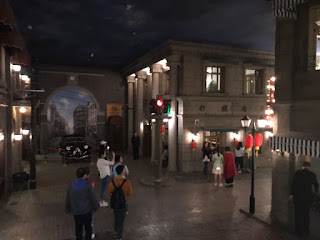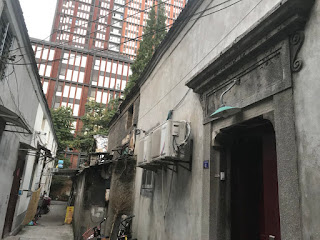That 10 year period in Chinese history is known by historians as the Nanjing Decade, and was a period of unprecedented modernization and industrialization but too had it's instability and unrest.
Nanjing's 20th Century stint of being the Capital was cut short by the Japanese invasion in 1937 which resulted in the capture of the city by the invaders and the infamous massacre of some 300,000 men, women and children in what was known as the Rape of Nanking.
Since the defeat of the Japanese and subsequent victory of the communists in the Civil War, Beijing, and not Nanjing, has been the capital of the country.
But how much of Nanjing survives from when it was the Capital?
First, of course, there was the damage caused by the Japanese, but then, in the past 30 years, has been the almost complete transformation of Chinese cities, not least their centers, due to the tower block and skyscraper boom. Old city centers have been bulldozed to make way for the new.
But, nevertheless, I got an idea of what Nanjing Decade Era Nanjing looked like through this wonderful replica street from that time in one of the wings of the Nanjing Museum.
What I particularly liked about the style of architecture shown was that it is, to me, a hybrid between traditional Chinese and Western influenced architecture of that period. But what I also wanted to know, was where I could find some real life examples.
Well, the Presidential Palace of Chiang Kai-Sheck, the anti-communist generalissimo who ruled from the city, was a good place to start.
In addition to all the history that was there (and that's all for another article), what I saw there was a wonderful combination of 'traditional chinese architecture', 'Western Art Decco' and 'Chinese Art Decco.'
And then of course, there's this major bank built in 1935, located at the central crossroads of Nanjing's Central Business district, which happens to be my local branch of ICBC. This is the building shortly after it's construction:
And these are some pictures I took of it while I've been here in 2018:
However, while these two very significant buildings clearly do have a safe future, the same does not seem to be true of more 'every day' buildings dating from that time, which is perhaps why I'm in such a hurry to photograph it all.
Perhaps less than 50 metres along from the bank, in Nanjing's Central Business District, is a line of what looks like to be 1920s and 30s architecture. Here it was in April 2018:
And here it is now, in July:
Notice the wooden green wall at the bottom. Yes, it's now been walled off, and the reason is well, obvious.
And are some more examples from Central Nanjing:
But what's interesting is that the new buildings that are going up in that area, are, in the majority at least, being built in a kind of neo-20's and 30's style, something that was absolutely not the case 20 years ago:
And that itself, is a greatly positive development. Just as how near the 'old town' area of Fuzimiao, where new buildings are being built in traditional Chinese architecture, so too it seems that many of the new builds in early 20th century districts are being built to imitate that style.
And that certainly wasn't the case 20 years ago - in the area photographed above, just east of Xinjeikou, buildings from the 80s and 90s are all in soulless modern style, compared to what's going up now. That itself is a cause for optimism, even if the original '20s and '30s buildings are still largely going away.
But what do the people think?
Whenever I've come across older sections of town, I've always been keen to ask the locals what they think of their homes, and this particular trip was no different. Also a good opportunity to further practice my Mandarin, of course.
When I told one lady that I liked taking pictures of old buildings, she quickly pointed out where a whole lot more still lay around. When I asked her if she liked them, she said she did and shared my interest.
However when I got there, I got talking to a resident who expressed her view that their demolition, which would likely happen in a few years, equaled progress and that she much preferred to look at the 21st century space age new build across the road, than at her own old terrace.
Both sets of opinions I have encountered but the former opinion I would say has seemed more common. And while I'm at it, here are some pics of that 'block' or so, of older Nanjing:
And here are some other older buildings around that area:
And here is the modern block that the second lady thought was much nicer to look at:
Either way, attitudes to building conservation have changed massively in the past two decades, let alone since the cultural revolution and discovering such differing attitudes on the street was extremely revealing.
Just like in any other country, individual citizens have differing attitudes towards the changes that they see around them. For me, discovering those opinions, and the architecture itself of course, was well worth those trips.

























No comments:
Post a Comment